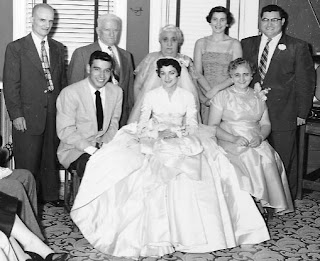 |
| The 1st good clue in my challenge: naturalization papers. |
What if a simple genealogy challenge could:
- Show you how good your genealogy skills are?
- Help you connect with a new friend?
- Teach you some new research tricks?
Would you accept it?
A Challenge Arises
The other day a woman reached out to me longing to know about her lost Italian roots. Her grandfather Matthew had given up his Italian name to blend into American society. After Matthew and his wife divorced, their children had very little contact with either of their parents.
The woman who wrote to me loved her grandfather, but knew nothing about his origins. She offered me the few clues she had, and asked if I could help.
Challenge Accepted
When an assignment comes my way in life or at work, I like to take a peek at it and figure out how hard or easy it might be. Many times this quick peek hooks me. I'm interested, and I'm making progress. So I dive in and get to work. That's exactly how I began this challenge.
Here are the few facts I had:
- Mattio d'Arcangelo was born in 1900 to Valentino and "Ginny"
- He married Evangeline McElroy and owned a shoe company in Boston
- His children, Eleanor and Robert, were given Mattio's adopted last name of Matthew.
- Mattio and Evangeline divorced.
I wasn't getting anywhere searching Ancestry.com for Mattio. I switched to searching for his father, Valentino. I thought his distinctive name would make him easier to find.
Right away I found naturalization records for Valentino d'Arcangelo. I scoured the information, but I had no proof yet that this was the father of Mattio. His naturalization papers did not mention any family members. But they did include his exact birth date.
That May 10, 1873 date helped me match him to other records for Valentino d'Arcangelo. I found a Massachusetts marriage registry book showing the January 12, 1900, Haverhill, Massachusetts marriage of:
- Valentino d'Arcangelo, age 26, a shoemaker from Italy, son of Mattio d'Arcangelo and Maria Porrea, and
- Giovannina d'Arcangelo, age 25, from Italy, daughter of Raffaele d'Arcangelo and Felice Subrizio.
There was a good chance Giovannina is the real name of Mattio's mother "Ginny". But I needed more proof.
 |
| This 1910 census provides 2 great aunts and a great uncle. |
I found the 1910 census for Haverhill, and there they were. A family of 6: Valentino and Giovannina (now called Jenny or Jinny), and their children Mattio, Assunta, Pastiano and Mary. Mattio was born in Massachusetts, but his younger sister was born in Italy. The census taker crossed out Massachusetts for Assunta, and wrote in Italy.
A 1902 ship manifest supports the idea of the family returning to Italy for a while. In November 1902 Valentino is returning to America—to Haverhill—without his family. Giovannina and her first 2 children must have returned at a later date.
I found out from the manifest that Valentino was from the town of Bisegna in the province of L'Aquila. Unfortunately, there are no birth records available online for Bisegna after 1866.
I went on to find Valentino as a widower in the 1920 census. A death index shows he died in 1942.
I wanted some more documentation for Mattio—my new friend's grandfather. I saw that his memorial on Find-a-Grave has his name as Matthew F. Matthews. When I couldn't find him in the 1930 census, I looked for his wife Evangeline, and his kids Eleanor and Robert.
 |
| Mattio d'Arcangelo, aka Francis Matthews. |
I found them living in Needham, Massachusetts, but the head-of-household was Francis Matthews. That memorial with the middle initial F. turned out to be a good clue.
They were a family unit in 1930. But in 1932, Evangeline McElroy Matthews remarried right there in Needham. I went back to the 1920 census to discover Evangeline's parents. That family of 4 consisted of:
- Robert the father
- Evangeline the mother
- Evangeline the daughter, and
- Robert the son!
I'd discovered quite a bit in one sitting. Mattio's granddaughter was just about in tears.
Your Challenge
Here are 3 ways you can find a genealogy challenge:
- Join any genealogy group on Facebook. Every day people ask for help. They may list some of their ancestors' names and dates and ask how to find out more about these people.
- Got DNA? You may belong to websites that suggest DNA matches to you. I read about an avid genealogist who is researching and building trees for all his DNA matches so he can figure out their connection.
- Maybe you have a friend who's mildly interested in your genealogy hobby. Help get them hooked by starting their tree for them. Ask for some basics about their parents and grandparents: names, dates and places.
Use the clues, your genealogy resources and skills and see how much you can find. Be careful not to make assumptions. Let the facts point you in the right direction.
Document everything you find clearly and thoroughly. List the facts in chronological order and show where each fact came from. Provide this person with the facts and the documents you've found.
Imagine that you are a professional genealogist, and do the best work you possibly can.
Once you've tackled this challenge, you may want to take a fresh look at your family's brick walls!
And speaking of following the facts:






